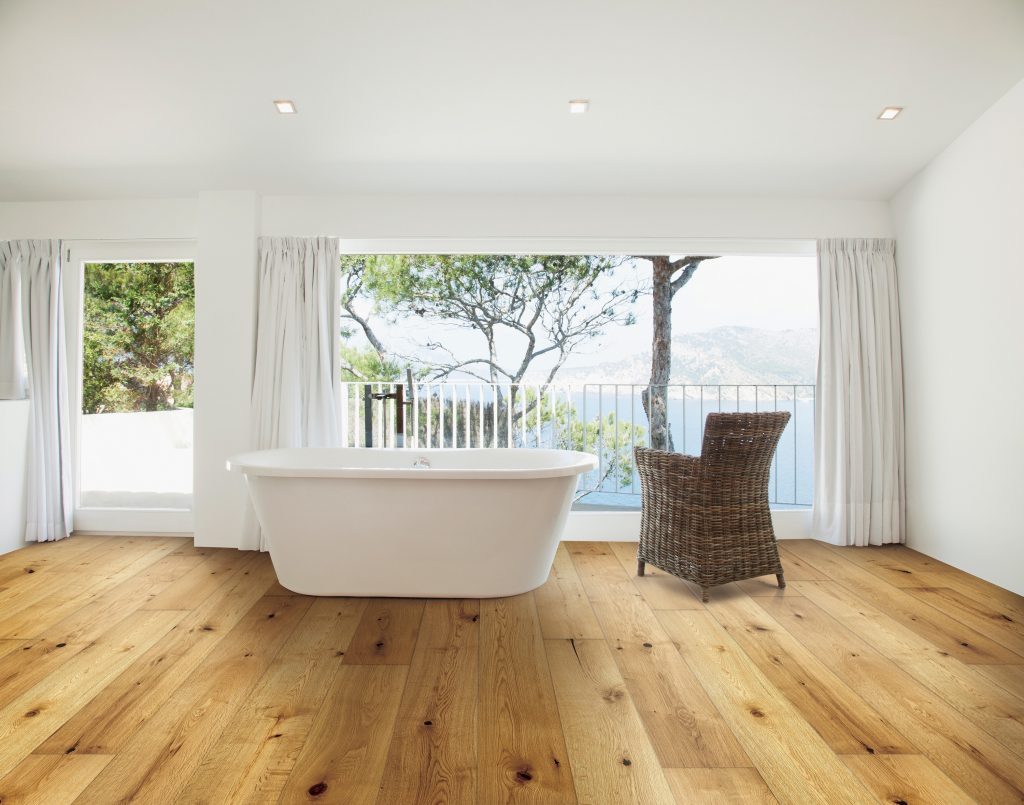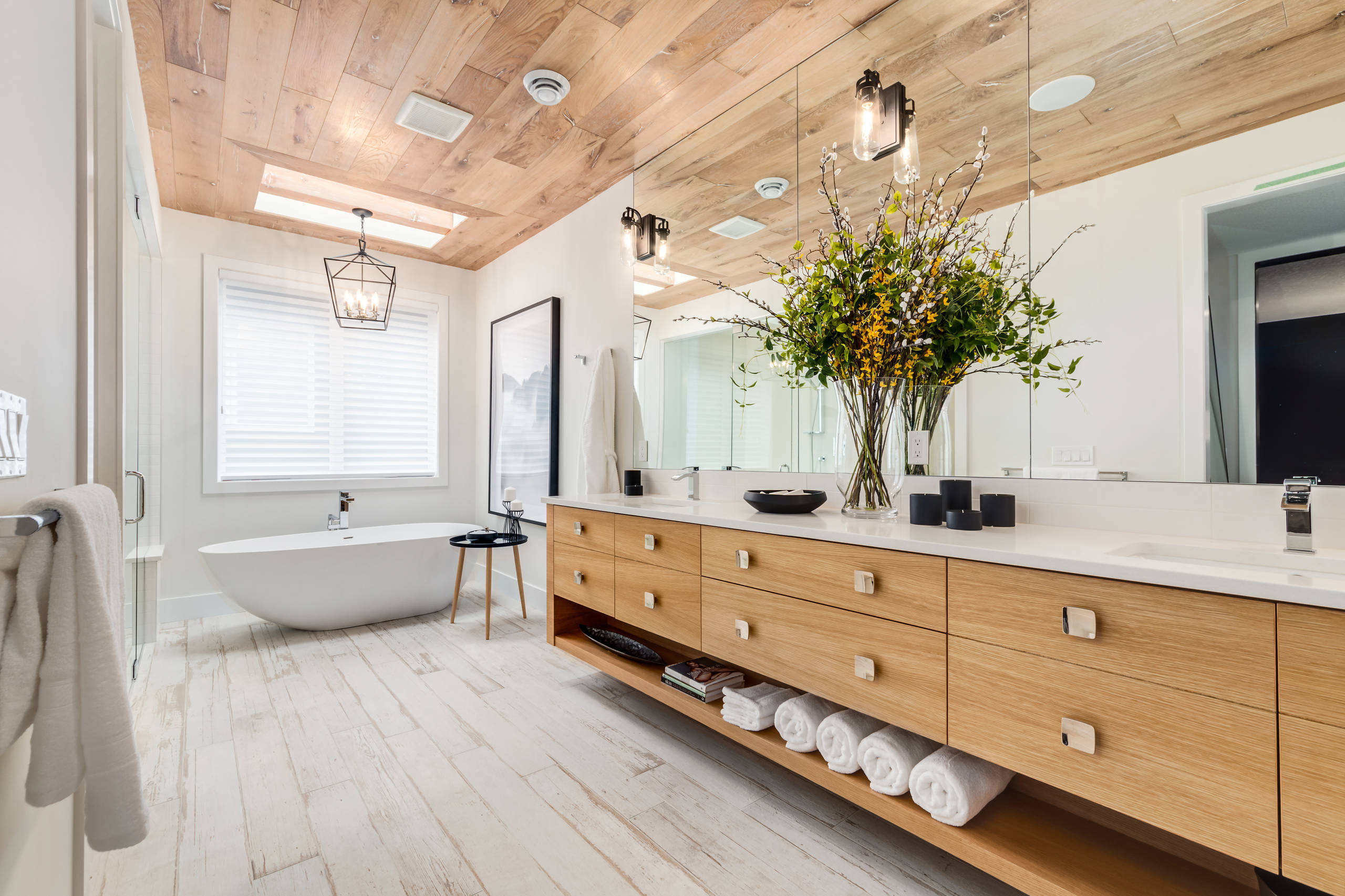Solid Wood Flooring

Solid wood flooring has long been a popular choice for living rooms, bedrooms, and hallways, but its suitability for bathrooms has been a subject of debate. While the potential for moisture damage exists, there are several advantages to using solid wood flooring in bathrooms, making it a viable option for those seeking a unique and elegant aesthetic.
Advantages of Solid Wood Flooring in Bathrooms
Solid wood flooring offers a number of advantages that can enhance the look and feel of a bathroom.
- Aesthetic Appeal: Solid wood flooring adds a touch of natural beauty and warmth to any space, creating a sophisticated and inviting ambiance. Its rich textures and colors can complement various bathroom styles, from traditional to modern.
- Durability: When properly maintained, solid wood flooring can withstand heavy foot traffic and last for decades. Its inherent strength and resilience make it a durable choice for high-traffic areas like bathrooms.
- Warmth and Comfort: Unlike cold tile or stone, solid wood flooring provides a warm and comfortable surface underfoot. This can be especially appreciated in bathrooms, where the floor can get cold, particularly in colder climates.
Types of Solid Wood Flooring Suitable for Bathrooms
Not all solid wood flooring is created equal when it comes to bathroom use. Some species and finishes are more resistant to moisture and water damage than others.
- Hardwood Species: Certain hardwood species, such as oak, maple, and cherry, are known for their durability and resistance to moisture. These woods are often treated with a sealant or finish to enhance their water resistance.
- Engineered Wood Flooring: Engineered wood flooring is a good option for bathrooms due to its moisture-resistant core. It consists of layers of wood veneer bonded together, with the top layer being a hardwood veneer. This construction makes it more stable and less prone to warping or cracking.
- Pre-Finished Flooring: Pre-finished flooring comes with a factory-applied finish that provides a protective barrier against moisture. This eliminates the need for on-site finishing, which can be a challenge in bathrooms.
Challenges of Using Solid Wood Flooring in Bathrooms, Solid wood flooring for bathrooms
While solid wood flooring can be a beautiful and durable choice for bathrooms, there are potential challenges that need to be addressed.
- Moisture Damage: Solid wood flooring is susceptible to moisture damage, which can lead to warping, cracking, and mold growth. Proper ventilation and water management are crucial to prevent this.
- Maintenance: Solid wood flooring requires regular maintenance to keep it looking its best. This includes sweeping, mopping, and occasional refinishing. Proper cleaning and care are essential to protect the wood from moisture damage and maintain its beauty.
- Cost: Solid wood flooring can be more expensive than other flooring options, such as tile or vinyl. However, its durability and longevity can make it a worthwhile investment in the long run.
Choosing the Right Wood Species and Finish: Solid Wood Flooring For Bathrooms
/luxurious-bathroom-157434905-5c55ffc146e0fb0001c089a0.jpg)
Selecting the right wood species and finish is crucial for ensuring the durability, beauty, and longevity of your bathroom flooring. The bathroom environment presents unique challenges, with high humidity, potential water spills, and the constant presence of moisture. Therefore, choosing the right materials is essential to prevent warping, rotting, and other damage.
Wood Species for Bathroom Flooring
The choice of wood species significantly impacts the performance and aesthetics of your bathroom flooring. Consider the following factors when making your decision:
- Hardness: Hardwood species like oak, maple, and hickory are known for their durability and resistance to scratches and dents, making them suitable for high-traffic areas.
- Moisture Resistance: Certain wood species are naturally more resistant to moisture than others. Teak, ipe, and mahogany are known for their high oil content, which provides excellent water resistance.
- Appearance: Wood species come in a wide range of colors, grains, and textures, allowing you to create the desired aesthetic for your bathroom.
| Wood Species | Hardness (Janka Scale) | Moisture Resistance | Appearance |
|---|---|---|---|
| Oak | 1360 | Moderate | Warm, reddish-brown tones; prominent grain patterns |
| Maple | 1450 | Moderate | Pale yellow to reddish-brown tones; tight, even grain |
| Hickory | 1820 | Moderate | Light brown to reddish-brown tones; distinctive, swirling grain patterns |
| Teak | 1050 | High | Rich, golden-brown tones; oily, durable surface |
| Ipe | 3680 | Very High | Dark brown to reddish-brown tones; dense, durable wood |
| Mahogany | 800 | Moderate | Deep reddish-brown tones; attractive, swirling grain patterns |
Selecting the Right Wood Finish
Once you’ve chosen your wood species, the next step is to select the appropriate finish. The finish plays a vital role in protecting your flooring from moisture, stains, and wear and tear.
- Water Resistance: A good finish creates a protective barrier against water, preventing it from penetrating the wood and causing damage.
- Stain Resistance: The finish helps to repel stains from spills and everyday use, keeping your floor looking clean and pristine.
- Longevity: A durable finish can extend the life of your wood flooring by protecting it from wear and tear, scratches, and fading.
Types of Wood Finishes for Bathrooms
Several types of finishes are available for bathroom flooring, each with its own advantages and disadvantages.
- Oil-Based Finishes: Oil-based finishes penetrate deep into the wood, providing excellent protection and a natural look. However, they can take a long time to dry and may require multiple coats. They also tend to be more susceptible to scratches and water damage.
- Polyurethane Finishes: Polyurethane finishes create a durable, water-resistant barrier over the wood. They are available in both oil-based and water-based formulas, with water-based options offering faster drying times and lower VOCs.
- Waxes: Waxes provide a protective layer over the wood, offering a soft sheen and enhancing the natural beauty of the wood. However, waxes are not as durable as other finishes and require regular reapplication.
Installation and Maintenance Tips

Installing solid wood flooring in a bathroom requires careful planning and execution to ensure its longevity and beauty. This section provides a comprehensive guide to installing solid wood flooring in bathrooms, covering subfloor preparation, acclimation, and installation techniques. It also delves into essential maintenance practices, including regular cleaning, sealing, and addressing potential water damage.
Subfloor Preparation
Proper subfloor preparation is crucial for a successful solid wood flooring installation. The subfloor must be level, flat, and free of any imperfections. This ensures the flooring planks are installed evenly and prevent future problems like squeaking or uneven wear.
- Leveling the Subfloor: Uneven subfloors can cause uneven wear and tear on the flooring. Use a leveling compound to fill in any low spots and create a smooth, level surface.
- Moisture Barrier: Bathrooms are prone to moisture, so a moisture barrier is essential. Install a moisture-resistant membrane over the subfloor to prevent moisture from penetrating the wood planks.
- Structural Integrity: Ensure the subfloor is structurally sound and can support the weight of the flooring. If necessary, reinforce the subfloor with additional joists or plywood.
Acclimation of Wood Planks
Acclimating wood planks to the bathroom environment is crucial to prevent warping, cupping, or shrinking after installation. This process allows the wood to adjust to the humidity and temperature of the bathroom.
- Storage: Store the wood planks in the bathroom for at least 72 hours before installation. This allows the wood to adjust to the humidity and temperature of the room.
- Ventilation: Ensure the bathroom is well-ventilated during the acclimation period. This helps to maintain a stable humidity level and prevent moisture buildup.
- Temperature: Ideal acclimation temperature is between 65-75 degrees Fahrenheit.
Installation Techniques
Proper installation techniques are essential for a long-lasting and aesthetically pleasing solid wood floor. Here are some important considerations:
- Installation Method: Choose a suitable installation method, such as nail-down, glue-down, or floating. Consult with a flooring professional to determine the best option for your bathroom.
- Expansion Gaps: Leave expansion gaps around the perimeter of the room and between planks to allow for wood movement due to changes in humidity and temperature.
- Staggering Joints: Stagger the joints of adjacent planks to create a more visually appealing pattern and enhance structural integrity.
Maintenance
Regular maintenance is crucial for preserving the beauty and longevity of solid wood bathroom flooring.
- Cleaning: Sweep or vacuum the floor regularly to remove dirt and debris. For deeper cleaning, use a damp mop with a mild cleaner specifically designed for wood floors. Avoid harsh chemicals or abrasive cleaners that can damage the finish.
- Sealing: Apply a sealant to the floor every 1-2 years to protect it from moisture and stains. Choose a sealant specifically designed for bathroom floors and follow the manufacturer’s instructions.
- Water Damage: Address any water spills promptly to prevent damage. Wipe up spills immediately and dry the affected area thoroughly. If water penetrates the wood, contact a professional for repairs.
Protecting from Moisture
- Rugs and Mats: Use rugs and mats in high-traffic areas to absorb moisture and protect the floor from scratches and scuffs. Choose rugs and mats with a non-slip backing to prevent accidents.
- Ventilation: Ensure adequate ventilation in the bathroom to prevent moisture buildup. Use an exhaust fan to remove steam and moisture after showers or baths.
- Water-Resistant Finish: Choose a water-resistant finish for your solid wood flooring to provide an extra layer of protection against moisture.
Solid wood flooring for bathrooms – While solid wood flooring in bathrooms might seem unconventional, it can offer a unique and stylish touch. If you’re considering a darker aesthetic, exploring dark bathroom floor pictures can provide inspiration. Remember to choose wood species known for their water resistance and consider a sealant for added protection to ensure your solid wood flooring thrives in the bathroom environment.
Solid wood flooring in bathrooms can add a touch of warmth and elegance, but careful planning is essential. A well-designed floor plan, like this floor plan master bathroom with closet , can help ensure the wood is installed in a way that maximizes its beauty while minimizing potential moisture damage.
Consider using waterproof finishes and strategically placed ventilation to protect your investment and enjoy the timeless appeal of solid wood flooring in your bathroom.